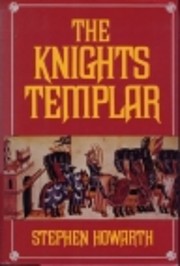

Carregue numa fotografia para ir para os Livros Google.
|
A carregar... Knights Templar (1982)por Stephen Howarth
 Nenhum(a) Ainda não há conversas na Discussão sobre este livro. 2525 The Knights Templar, by Stephen Howarth (read 1 Aug 1993) This book is a "popular" account of the order, and not very profound. I found little new in its account of the Crusades, but the couple of chapters on Philip the Fair's destruction of the order was informative, as was the one on the structure of the order. Clearly the Templars were not guilty, but the forced confessions may have misled the Church authorities. It is a sad story. sem críticas | adicionar uma crítica
Here is a complete account of one of the strangest phenomena of medieval history : The Poor Fellow Soldiers of Christ, the Knights of the Temple of Solomon--more popularly known as the Knights Templar. In their brotherhood, the Knights united two conflicting medieval ideals, for they were both monks and warriors, committed to God and committed to war. In the strict hierarchy of the feudal world, where every man owed loyalty and allegiance to his overlord, the Templars obeyed no one except the Pope. Acquiring land and castles by gift conquest and purchase in every part of Europe and the eastern Mediterranean, they became a church within the Church--a state within the State. They were bankers, merchants, diplomats and tax gatherers and though themselves poor, the wealth of their order was legendary. They led the Crusades against Moslem States of the East, yet when their order was destroyed in 1314, its enemies were not Muslims but Christians. Individually and as a group they were accused of heresy, treachery, sodomy, usury, blasphemy, idolatry and a number of unspeakable sins. Pope Clement to whom the Order owed complete allegiance described them as 'horrible, wicked and detestable'. This book charts the rise and fall of the Order, tracing the lives and deaths of its members and examining the motives of its supporters and opponents. Não foram encontradas descrições de bibliotecas. |
Current DiscussionsNenhum(a)Capas populares
 Google Books — A carregar... Google Books — A carregar...GénerosSistema Decimal de Melvil (DDC)271.79Religions History, geographic treatment, biography of Christianity Religious Congregations and Orders in Church history Lesser Roman orders Other lesser Roman ordersClassificação da Biblioteca do Congresso dos EUA (LCC)AvaliaçãoMédia: (3.48) (3.48)
É você?Torne-se num Autor LibraryThing. |
||||||||||||||||||||||||||||||||||||||||||||||||||||||||||||||||||||||||||||||||||||||||||||||||||||||||||||||||||||||||
Azért megjegyzem: a templomos rend felszámolásának leírásakor több feltételezést is belemos az író a szövegbe, de mértékkel teszi. Merészebb választ nem is hajlandó megkockáztatni az Umberto Eco-t is foglalkoztató Nagy Kérdésre*, mint hogy a templomos rend szervezeti felépítése az idők során egészségtelenül merevvé vált, ellentétben az ispotályosokéval, akik képesek voltak reagálni a megváltozott történelmi környezetre. Utóbbiak Jeruzsálem elvesztése után sikeresen átképezték magukat a Földközi-tenger kereskedelmi útvonalainak őrzőivé, szerencsétlen templomosok meg továbbra is a Szentföldről álmodoztak – nem vették észre, hogy a keresztes háborúk ideje lejárt. Használhatatlan, de veszélyes fegyverré váltak, és nem is tudtak róla.
Amúgy ez a könyv legalább annyira a keresztes háborúk, és a szentföldi frank államocskák (az Outremer) története, mint a lovagrendé. Aminek nagyon örülök, mert ezek olyan jelenségek, amik a mai napig kihatóan beárazták a kereszténységet az iszlám szemében. A sztereotípiák a kapzsi, intoleráns, civakodó és istentelen lovagokról a mai napig felbukkannak a radikális nyugat-ellenes diskurzusban**. Másfelől ez az eseménysor támasztotta fel a harcos próféta mítoszát is Szaladinnak köszönhetően, aki hívő, irgalmas, szavatartó és vitéz – mindent elmond róla, hogy még a frankok sem nagyon tudtak egy rossz szót mondani rá.
Engem azonban az nyűgöz le leginkább ebben az egészben, hogy egy ilyen ad hoc módon megtervezett, csapnivalóan kivitelezett, impotens vezetőkkel terhelt nyamvadt gyarmatosítás olyan államokat volt képes létrehozni, amik (hellyel-közzel) 200 évig megmaradtak a térségben. Foggal-körömmel kapaszkodtak a Szentföldbe, holott akinek szeme volt, láthatta, nem lesz ennek így jó vége. Ez a maga értelmetlen módján meglehetősen bámulatos. És az ő személyes hitükről épp olyan sokat elmond, mint az iszlám egység hiányáról – amit azért mellékesen sikerült megteremteniük. Úgyhogy ha valakinek jót tettek, hát azok a muzulmánok. Így megy ez.
* Ami pedig a következő: hogyan számolhatták fel néhány év alatt a korszak talán leggazdagabb, legszámottevőbb szervezetét anélkül, hogy igazán kemény ellenállásba ütköztek volna?
** Oszama 2002-es kiáltványában is központi szerepet kapott az analógia az USA és a XII. századi keresztény betolakodók között. Persze Oszama azt nem említette, hogy a hódítás spirálját valószínűleg az iszlám indította el azzal, hogy az őskeresztény Észak-Afrikát, és a mai Spanyolország jó részét elfoglalta. Ugyanakkor az erőszak spiráljának nem kis részben a keresztesek adták meg a kezdőlökést, amikor és ahogy 1099-ben elfoglalták Jeruzsálemet. Amely esemény kiválóan megmutatja a szakadékot a korszak keresztény és mohamedán tolerancia-elképzelése között is. (